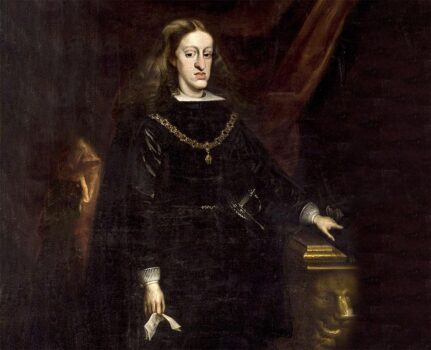The Tragic Life of Charles II of Spain: The Mad King of Habsburg
In the grand halls of European royalty, few lives are as tragic and enigmatic as that of Charles II of Spain. Born on November 6, 1661, in Madrid, Charles II was the last Habsburg king of Spain, a man whose life was marked by severe physical and mental disabilities, court intrigue, and a kingdom in decline. Known historically as “El Hechizado” , the Bewitched , or the “Mad King,” Charles II’s story is a cautionary tale about the dangers of dynastic inbreeding, political mismanagement, and the heavy burdens of monarchy.
A Life Preordained by Inbreeding
To understand why Charles II of Spain was deformed, one must look at the Habsburg dynasty itself. By the time of Charles’ birth, the Spanish Habsburgs had spent generations marrying within a closed circle of European royalty, often favoring cousins and close relatives to consolidate power and keep their empire intact. This obsessive practice, while politically advantageous in the short term, carried devastating genetic consequences.
Charles’ father, Philip IV of Spain, and his mother, Mariana of Austria, were uncle and niece. Their union was not unusual for the Habsburg family, but it produced offspring with extremely limited genetic diversity. Charles was the culmination of this long line of consanguineous marriages, and the consequences were tragically visible. The Habsburg jaw, a pronounced mandibular prognathism that caused problems with speech and eating, was particularly pronounced in Charles, giving his face a grotesque appearance by contemporary standards. Historical records indicate that he was also extremely frail, suffered from developmental delays, and was physically incapable of performing basic tasks independently.
The Physical and Mental Disabilities of Charles II
Charles II’s disabilities were numerous and severe. Physically, he suffered from a pronounced Habsburg jaw, a large tongue that impeded speech, and general muscular weakness. Contemporary accounts describe him as thin, sickly, and hunched, with an appearance that caused widespread speculation and horror at court. He had digestive problems, was often ill, and was reportedly infertile, a critical issue for a monarch whose dynasty’s survival depended on heirs.
Mentally, Charles faced a range of cognitive challenges. He exhibited delayed developmental milestones and was reportedly unable to read or write well, despite being tutored from an early age. He could not speak fluently and was described as having limited reasoning abilities, contributing to his reputation as “mad.” While the term “mad” might seem harsh today, in the context of 17th-century Europe, it reflected a combination of physical deformity, intellectual disability, and court rumors that magnified every weakness.
The combination of physical and cognitive disabilities made Charles completely dependent on his ministers and advisers. He was unable to assert authority effectively, and much of Spain’s governance during his reign was handled by regents, courtiers, and foreign diplomats who had their own agendas.
Why Was Charles II Called the Mad King?
Charles II’s moniker, “the Mad King,” was partly a result of his severe disabilities and partly the result of political perception. In a time when kings were expected to be strong, virile, and decisive, Charles’ frailty and intellectual challenges made him an easy target for gossip and political manipulation. His inability to speak properly or make independent decisions was often interpreted as evidence of madness or supernatural affliction.
The Spanish called him “El Hechizado” , literally “the Bewitched” , due to a belief that his deformities and misfortunes were the result of a curse or witchcraft. Superstition was rampant in 17th-century Europe, and the idea of a “bewitched” king fit well with the collective imagination. In reality, his condition was genetic, stemming from generations of Habsburg inbreeding. Modern geneticists have speculated that Charles suffered from combined congenital defects, possibly exacerbated by familial hemophilia, endocrine problems, and malnutrition.
Yet the term “mad” was not entirely inaccurate in the eyes of his contemporaries. Charles often displayed erratic behavior, bouts of irritability, and episodes of apparent confusion. These symptoms, coupled with his physical frailty, reinforced the perception of a mentally unstable ruler.
The Reign of a Weak King
Despite his disabilities, Charles II ascended to the Spanish throne in 1665, at the tender age of four, following the death of his father, Philip IV. Given his youth and incapacity, Spain was effectively governed by a series of regents. Initially, his mother, Mariana of Austria, acted as regent, navigating the treacherous waters of Spanish politics with the help of ministers and court factions. Charles’ reign, however, coincided with a period of political, economic, and military decline for Spain, a far cry from the empire that once dominated Europe and the Americas.
Under Charles II, Spain lost much of its former influence. Wars drained the treasury, internal rebellions simmered, and foreign powers exploited the weakened monarchy. Charles’ inability to provide strong leadership made him a pawn in the hands of ambitious courtiers and foreign diplomats. Yet despite his frailty, he was deeply religious, often spending long hours in prayer and confession, a devotion that earned him some sympathy among his subjects.
Charles’ personal life was equally troubled. He married twice , first to Marie Louise of Orléans and then to Maria Anna of Neuburg , but neither union produced an heir. His infertility, likely stemming from his physical deformities and possibly genetic issues, meant the Habsburg line in Spain would end with him, creating a dynastic crisis that would eventually plunge Europe into the War of Spanish Succession.
The Psychological and Social Impact of His Disabilities
Charles II’s disabilities were not merely physical or cognitive; they shaped the entire social and political environment of Spain. Court life was suffused with fear, pity, and intrigue. Courtiers often exploited his weaknesses to gain favor, control policy, or advance personal agendas. Foreign ambassadors treated him as a passive instrument, carefully negotiating treaties and alliances that favored their own countries.
The king’s isolation was profound. He reportedly spent much of his time in bed or wandering the palace corridors, barely able to engage in ordinary activities. His illness and deformities made public appearances difficult, and his subjects sometimes reacted with shock or pity when seeing their king. The psychological toll on Charles himself must have been immense, compounded by the constant awareness of his physical shortcomings and the burden of carrying a fading empire on his fragile shoulders.
The Habsburg Jaw and Genetic Legacy
One of the most striking features of Charles II was his pronounced mandibular prognathism, commonly known as the Habsburg jaw. This distinctive trait, inherited through generations of intermarriage, was a physical manifestation of the genetic problems that plagued the dynasty. The Habsburg jaw made it difficult for Charles to chew or speak properly, and it became a symbol of the dynasty’s decline.
Medical historians and geneticists have studied Charles II extensively, using contemporary accounts, portraits, and skeletal remains to reconstruct the possible medical conditions he suffered. Many believe he had a combination of endocrine disorders, gastrointestinal problems, and congenital deformities. His case is often cited as one of the most dramatic examples of the dangers of inbreeding in royal families.
The End of Charles II and the Fall of the Spanish Habsburgs
Charles II died on November 1, 1700, at the age of 38. His death marked the end of the Spanish Habsburg line, plunging Europe into a dynastic crisis. Without an heir, competing European powers sought to claim the Spanish throne, leading directly to the War of Spanish Succession, a conflict that would reshape the political map of Europe for decades.
The king’s final years were marked by illness and isolation. He spent much of his time in bed, suffering from the consequences of a lifetime of frailty and disease. Court physicians attempted various treatments, ranging from herbal remedies to bloodletting, but nothing alleviated his suffering. When he died, Spain was politically unstable, financially drained, and vulnerable to foreign intervention. Charles II’s personal tragedy thus mirrored the decline of his empire.
Legacy and Historical Interpretation
Charles II’s legacy is a complex mixture of pity, fascination, and historical lessons. On one hand, he is remembered as the “Mad King,” a ruler whose deformities and disabilities made him a tragic figure. On the other hand, his reign illustrates the broader consequences of political inbreeding, dynastic obsession, and neglect of state governance.
Modern historians emphasize that Charles was not inherently incapable; rather, his abilities were compromised by physical, cognitive, and social constraints imposed by centuries of dynastic choices. His reign highlights how personal health and genetics can have profound consequences for entire nations, especially in monarchic systems where the ruler’s body is inseparable from the state.
The story of Charles II of Spain is one of tragedy on both a personal and political scale. Deformed by generations of inbreeding, burdened by disabilities that limited his physical and cognitive abilities, and trapped in a court filled with intrigue, Charles lived a life of immense suffering and historical significance. Called the “Mad King” and “the Bewitched,” he embodied the perils of dynastic obsession, the fragility of human health, and the inescapable influence of genetics on history.
Charles II’s death closed the chapter on the Spanish Habsburg dynasty, leaving a kingdom in turmoil and a Europe on the brink of war. Yet, centuries later, his life remains a compelling story , a human drama of weakness and resilience, a cautionary tale about power, and a reminder of the sometimes cruel interplay between heredity and history.




